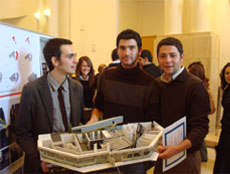 In
the 2006-2007 Spring Semester, Design Studio students from the Department of Interior
Architecture and Environmental Design, worked on a project that could be described as a
practical implementation exercise. TAI (Turkish Aerospace Industries) needed to renovate
their existing administrative building, and turned to Bilkent University to help organize
a student competition that would result in a new design for the offices they desired. In
the 2006-2007 Spring Semester, Design Studio students from the Department of Interior
Architecture and Environmental Design, worked on a project that could be described as a
practical implementation exercise. TAI (Turkish Aerospace Industries) needed to renovate
their existing administrative building, and turned to Bilkent University to help organize
a student competition that would result in a new design for the offices they desired.
It was a win-win situation for everyone involved, as TAI did gain the building concept
they wanted, students got practical academic experience, and valuable prizes were awarded.
The competition was limited to 3rd year Bilkent IAED students, under the direction of
Design Studio Instructors İnci Basa, Serpil Altay, Maya Öztürk, Herbert Bassler and
Turhan Kayasu.
TAI -being the center for the design, development, manufacturing, system integration,
modernization and servicing of aircraft in Turkey - wishes to become a globally recognized
brand. Thus, an impressive administrative building that reflects this goal was required -
one that not only looks good and creates a spatial identity, but one that would fulfill
TAI's functional needs.
The top three teams are as follows:
First prize: Yiğit Kale, Ali Cin, Bahadır Ersözoğlu
Second prize: Melodi Öz, Semra Horuz, Şinasi Uluer
Third prize: Cansın Şengül, Elif Yükser, Kaan Yıldız
In the competition, there were 24 teams of three students each. Eight teams were awarded a
total of three prizes and five mentions (with a complete purse of 5000 YTL) by a jury
which included TAI representatives. Two special awards were also given by the Department
of Interior Architecture and Environmental Design.
An award ceremony and exhibition was held in the FADA building atrium on October 16, in
the presence of TAI General Director Muharrem Dörtkaşlı, and senior officials Ahmet
Metan and İsmail Ulubayram. Also in attendance were the Dean of FADA, Prof. Dr. Bülent
Özgüç; IAED Chair Assoc. Prof. Halime Demirkan; and IAED academic staff and students.
The competition and the resulting implementation of the design was an enriching experience
for all parties involved. It met the expectations of TAI representatives who expressed
their intention to continue such collaborations.

|







